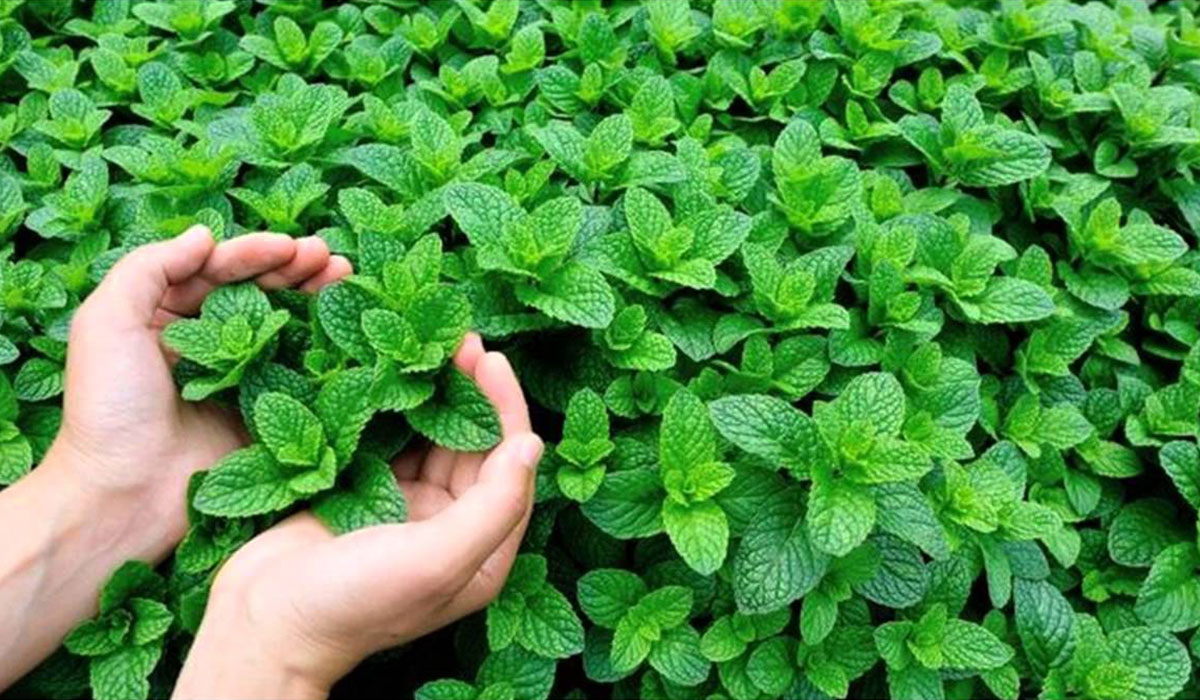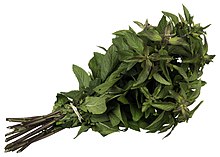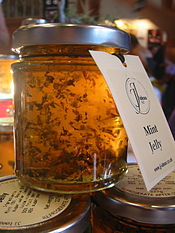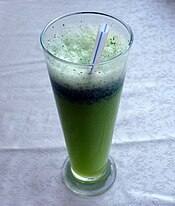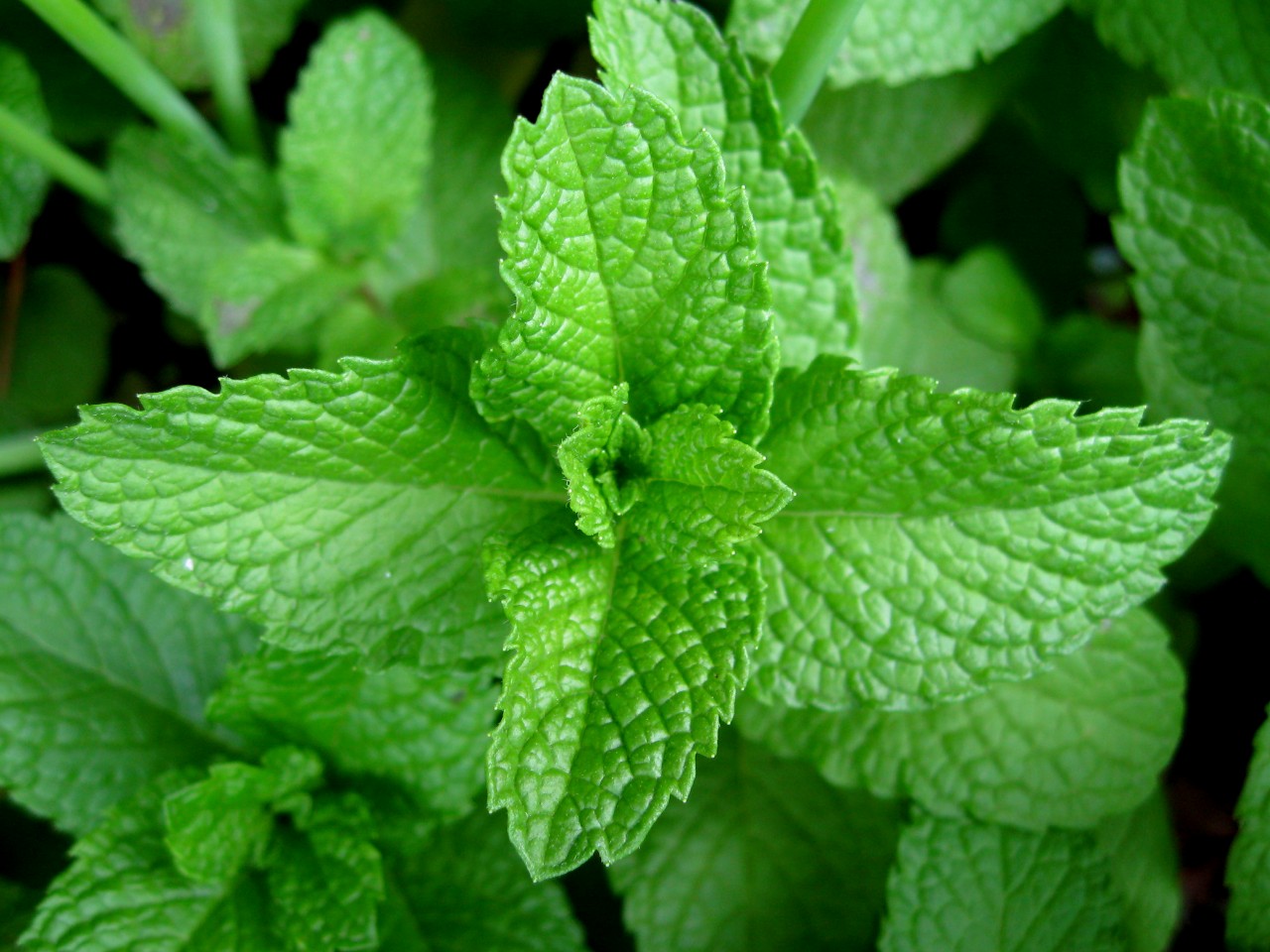


ــــــــــــــــــــــــــــــــ


Mentha
Jump to navigationJump to search
| Mentha | |
|---|---|
 |
|
| Mentha × piperita (Peppermint) | |
| Scientific classification |
|
| Kingdom: | Plantae |
| Clade: | Tracheophytes |
| Clade: | Angiosperms |
| Clade: | Eudicots |
| Clade: | Asterids |
| Order: | Lamiales |
| Family: | Lamiaceae |
| Subfamily: | Nepetoideae |
| Tribe: | Mentheae |
| Genus: | Mentha L. |
| Type species | |
| Mentha spicata | |
| Synonyms[1] | |
Mentha (also known as mint, from Greek μίνθα míntha,[2] Linear B mi-ta[3]) is a genus of plants in the family Lamiaceae (mint family).[4] The exact distinction between species is unclear; it is estimated that 13 to 24 species exist.[5][1] Hybridization occurs naturally where some species range overlap. Many hybrids and cultivars are known.
The genus has a subcosmopolitan distribution across Europe, Africa, Asia, Australia, and North America.[6]
The species that makes up the genus Mentha are widely distributed and can be found in many environments. Most grow best in wet environments and moist soils. Mints will grow 10–120 cm tall and can spread over an indeterminate area. Due to their tendency to spread unchecked, some mints are considered invasive.[7]
Mints are aromatic, almost exclusively perennial herbs. They have wide-spreading underground and overground stolons[8] and erect, square,[9] branched stems. The leaves are arranged in opposite pairs, from oblong to lanceolate, often downy, and with a serrated margin. Leaf colors range from dark green and gray-green to purple, blue, and sometimes pale yellow.[6] The flowers are white to purple and produced in false whorls called verticillasters. The corolla is two-lipped with four subequal lobes, the upper lobe usually the largest. The fruit is a nutlet, containing one to four seeds.
Taxonomy
Mentha is a member of the tribe Mentheae in the subfamily Nepetoideae. The tribe contains about 65 genera, and relationships within it remain obscure.[4] Authors have disagreed on the circumscription of Mentha. For example, M. cervina has been placed in Pulegium and Preslia, and M. cunninghamii has been placed in Micromeria.[10] In 2004, a molecular phylogenetic study indicated that both M. cervina and M. cunninghamii should be included in Mentha.[5] However, M. cunninghamii was excluded in a 2007 treatment of the genus.[10]
More than 3,000 names have been published in the genus Mentha, at ranks from species to forms, the majority of which are regarded as synonyms or illegitimate names. The taxonomy of the genus is made difficult because many species hybridize readily, or are themselves derived from possibly ancient hybridization events. Seeds from hybrids give rise to variable offspring, which may spread through vegetative propagation. The variability has led to what has been described as “paroxysms of species and subspecific taxa”; for example, one taxonomist published 434 new mint taxa for central Europe alone between 1911 and 1916.[10] Recent sources recognize between 18[10] and 24[1] species.
Species
As of July 2019, Plants of the World Online recognized the following species:[1]
- Mentha alaica Boriss.
- Mentha aquatica L. – water mint, marsh mint
- Mentha arvensis L. – corn mint, wild mint, Japanese peppermint, field mint, banana mint
- Mentha atrolilacina B.J.Conn & D.J.Duval
- Mentha australis R.Br. – Australian mint
- Mentha canadensis L. – Canada mint, American wild mint
- Mentha cervina L. – Hart’s pennyroyal
- Mentha cunninghamii (Benth.) Benth.
- Mentha dahurica Fisch. ex Benth. – Dahurian thyme
- Mentha darvasica Boriss.
- Mentha diemenica Spreng. – slender mint
- Mentha gattefossei Maire
- Mentha grandiflora Benth.
- Mentha japonica (Miq.) Makino
- Mentha laxiflora Benth. – forest mint
- Mentha longifolia (L.) L. – horse mint
- Mentha micrantha (Fisch. ex Benth.) Heinr.Braun
- Mentha pamiroalaica Boriss.
- Mentha pulegium L. – pennyroyal
- Mentha requienii Benth. – Corsican mint
- Mentha royleana Wall. ex Benth.
- Mentha satureioides R.Br. – native pennyroyal
- Mentha spicata L. – spearmint, garden mint (a cultivar of spearmint)
- Mentha suaveolens Ehrh. – apple mint, pineapple mint (a variegated cultivar of apple mint)
- Mentha aquatica brevis Ehrh. – apple mint, pineapple mint (a variegated cultivar of apple mint)
Hybrids
The mint genus has a large grouping of recognized hybrids. Those accepted by Plants of the World Online are listed below.[1] Parent species are taken from Tucker & Naczi (2007).[10] Synonyms, along with cultivars and varieties where available, are included within the specific nothospecies.
- Mentha × carinthiaca Host (M. arvensis × M. suaveolens)
- Mentha × dalmatica Tausch (M. arvensis × M. longifolia)
- Mentha × dumetorum Schult. (M. aquatica × M. longifolia)
- Mentha × gayeri Trautm.
- Mentha × gentilis L. (syn. Mentha × gracilis; M. arvensis × M. spicata) – ginger mint, Scotch spearmint
- Mentha × kuemmerlei Trautm.
- Mentha × locyana Borbás
- Mentha × piperita L. (M. aquatica × M. spicata) – peppermint, chocolate mint
- Mentha × pyramidalis Ten.
- Mentha × rotundifolia (L.) Huds. (M. longifolia × M. suaveolens) – false apple mint
- Mentha × suavis Guss. (syn. Mentha × maximilianea; M. aquatica × M. suaveolens)
- Mentha × verticillata L. (M. aquatica × M. arvensis)
- Mentha × villosa Huds. (M. spicata × M. suaveolens, also called M. nemorosa) – large apple mint, foxtail mint, hairy mint, woolly mint, Cuban mint, mojito mint, and yerba buena in Cuba
- Mentha × villosa-nervata Opiz (M. longifolia × M. spicata) – sharp-toothed mint
- Mentha × wirtgeniana F.W.Schultz (syn. Mentha × smithiana; M. aquatica × M. arvensis × M. spicata) – red raripila mint
Cultivation
All mints thrive near pools of water, lakes, rivers, and cool moist spots in partial shade.[11] In general, mints tolerate a wide range of conditions, and can also be grown in full sun. Mint grows all year round.[12]
They are fast-growing, extending their reach along surfaces through a network of runners. Due to their speedy growth, one plant of each desired mint, along with a little care, will provide more than enough mint for home use. Some mint species are more invasive than others. Even with the less invasive mints, care should be taken when mixing any mint with any other plants, lest the mint take over. To control mints in an open environment, they should be planted in deep, bottomless containers sunk in the ground, or planted above ground in tubs and barrels.[11]
Some mints can be propagated by seed, but growth from seed can be an unreliable method for raising mint for two reasons: mint seeds are highly variable — one might not end up with what one supposed was planted[11] — and some mint varieties are sterile. It is more effective to take and plant cuttings from the runners of healthy mints.
The most common and popular mints for commercial cultivation are peppermint (Mentha × piperita), native spearmint (Mentha spicata), Scotch spearmint (Mentha x gracilis), and cornmint (Mentha arvensis);[13] also (more recently) apple mint (Mentha suaveolens).
Mints are supposed to make good companion plants, repelling pesty insects and attracting beneficial ones. They are susceptible to whitefly and aphids.
Harvesting of mint leaves can be done at any time. Fresh leaves should be used immediately or stored up to a few days in plastic bags in a refrigerator. Optionally, leaves can be frozen in ice cube trays. Dried mint leaves should be stored in an airtight container placed in a cool, dark, dry area.[14]
Uses
|
|
This section may lack focus or may be about more than one topic. In particular, it treats the genus Mentha (“mint”) as if it were a single kind of plant, whereas many of the uses apply only to one species or cultivated variety of the genus. (July 2019)
|
Culinary
The leaf, fresh or dried, is the culinary source of mint. Fresh mint is usually preferred over dried mint when storage of the mint is not a problem. The leaves have a warm, fresh, aromatic, sweet flavor with a cool aftertaste, and are used in teas, beverages, jellies, syrups, candies, and ice creams. In Middle Eastern cuisine, mint is used in lamb dishes, while in British cuisine and American cuisine, mint sauce and mint jelly are used, respectively.
Mint is a necessary ingredient in Touareg tea, a popular tea in northern African and Arab countries. Tea in Arab countries is popularly drunk this way. Alcoholic drinks sometimes feature mint for flavor or garnish, such as the mint julep and the mojito. Crème de menthe is a mint-flavored liqueur used in drinks such as the grasshopper.
Mint essential oil and menthol are extensively used as flavorings in breath fresheners, drinks, antiseptic mouth rinses, toothpaste, chewing gum, desserts, and candies, such as mint (candy) and mint chocolate. The substances that give the mints their characteristic aromas and flavors are menthol (the main aroma of peppermint and Japanese peppermint) and pulegone (in pennyroyal and Corsican mint). The compound primarily responsible for the aroma and flavor of spearmint is L–carvone.
Mints are used as food plants by the larvae of some Lepidoptera species, including buff ermine moths. It is also eaten by beetles such as Chrysolina coerulans (blue mint beetle)[15][16] and Mint leaf beetle.[17]
Traditional medicine and cosmetics
Mint was originally used as a medicinal herb to treat stomach ache and chest pains.[18] There are several uses in traditional medicine[19] and preliminary research for possible use in treating irritable bowel syndrome.[18]
Menthol from mint essential oil (40–90%) is an ingredient of many cosmetics and some perfumes. Menthol and mint essential oil are also used in aromatherapy which may have clinical use to alleviate post-surgery nausea.[18][20]
Allergic reaction
Although it is used in many consumer products, mint may cause allergic reactions in some people, inducing symptoms such as abdominal cramps, diarrhea, headaches, heartburn, tingling or numbing around the mouth, anaphylaxis or contact dermatitis.[18][21]
Insecticides
Mint oil is also used as an environmentally friendly insecticide for its ability to kill some common pests such as wasps, hornets, ants, and cockroaches.[22]
Room scent and aromatherapy
Known in Greek mythology as the herb of hospitality,[23] one of mint’s first known uses in Europe was as a room deodorizer.[24] The herb was strewn across floors to cover the smell of the hard-packed soil. Stepping on the mint helped to spread its scent through the room. Today, it is more commonly used for aromatherapy through the use of essential oils.
Diseases
Etymology of “mint”
Mint descends from the Latin word mentha, which is rooted in the Greek word minthe, personified in Greek mythology as Minthe, a nymph who was transformed into a mint plant, and reflex of a proto-Indo-European root whence also Sanskrit -mantha, mathana (premna serratifolia).
Mint leaves, without a qualifier like ‘peppermint’ or ‘apple mint’, generally refers to spearmint leaves.
In Spain and Central and South America, mint is known as menta. In Lusophone countries, especially in Portugal, mint species are popularly known as hortelã. In many Indo-Aryan languages, it is called pudīna, (Sindhi: ڦُودنو), Hindi: पुदीना , (Bengali: পুদিনা).
The taxonomic family Lamiaceae is known as the mint family. It includes many other aromatic herbs, including most of the more common cooking herbs, such as basil, rosemary, sage, oregano, and catnip.
As an English colloquial term, any small mint-flavored confectionery item can be called a mint.[25]
In common usage, other plants with fragrant leaves may be called “mint”, although they are not in the mint family.
- Vietnamese mint, commonly used in Southeast Asian cuisine is Persicaria odorata in the family Polygonaceae, collectively known as smartweeds or pinkweeds.
- Mexican mint marigold is Tagetes lucida in the sunflower family (Asteraceae).
- ــــــــــــــــــــــــــــــــــــــــــــــــــــــــــــــــــــــــ

-
نبات النعناع
-
Mentha
النعناع
نعناع من فصيلة طويل الأوراق.
المرتبة التصنيفية جنس[1] التصنيف العلمي النطاق: حقيقيات النوى المملكة: نباتات العويلم: النباتات الخضراء غير مصنف: النباتات الوعائية غير مصنف: حقيقيات الأوراق غير مصنف: البذريات غير مصنف: كاسيات البذور العمارة: النعناعينة غير مصنف: ثنائيات الفلقة غير مصنف: النجميانيات غير مصنف: اللاميوناوايات الرتبة: الشفويات الفصيلة: الشفوية الأسرة: القطرماوات القبيلة: النعناعاوية العميرة: النعناعينة الجنس: النعناع الاسم العلمي Mentha [1][2]
كارولوس لينيوس، 1753 معرض صور نعناع – ويكيميديا كومنز
معرض صور نعناع – ويكيميديا كومنز النَّعْنَاع أو النَّعْنَع أو النُّعْنُع (الاسم العلمي: Mentha) هو جنس من النباتات يتبع الفصيلة الشفوية من رتبة الشفويات[3]، ويضم ما بين 42 نوعاً مقبولاً وعشرات الأنواع غير المؤكدة.[4]، وتحدث الهجائن بين الأنواع بشكل طبيعي. نباتات هذا الجنس عشبية معمرة ذات رائحة نفاذة محببة. وينتشر بشكل شبه عالمي حول قارة أوروبا، وأفريقيا، وآسيا، وأستراليا وأمريكا الشمالية.[5] وهو نبات مُعمر ونادراً ما يكون نبات حولي، وله أرآد تنتشر بشكل واسع تحت وحول الأرض[6]. وسيقانه مربعة، متشعبة ومنتصبة[7]. تترتب الأوراق بشكل أزواج متعاكسة ويتراوح شكلها بين المربعي والرمحي، وهي ملساء الملمس غالباً وبأطراف مشرشرة. تتفاوت ألوان الأوراق من أخضر غامق وأخضر رمادي إلى البنفسجي، والأزرق وبعض الأحيان أصفر فاتح[5]. ولزهورها لون أبيض إلى بنفسجي.
وتنتشر أنواع جنس النعناع بشكل واسع، ويمكن العثور عليها في العديد من البيئات، ينمو أغلبها بشكل أفضل في البيئات والتُرّب الرطبة، وينمو النعناع ليصل طوله من 10 إلى 120 سم، ويمكن له الإنتشار في المكان بشكل غير محدد، وبسبب قابليته للانتشار بشكل طليق، يمكن اعتبار بعض أنواع النعناع كنبات مجتاح. [8].
ينبت على أطراف السواقي والمجمعات المائية، كما يمكن زراعته بنفس طريقة زراعة البقدونس، ويمكن استخدام النعناع في السلطات طازجاً أو يابساً. وتضاف بضع ورقات من النَّعْنَاع إلى إبريق الشاي ليضفي على الشاي نكهة طيبة. ويستخدم طبياً باستخلاص الزيوت الطيارة منه.
التسمية
النَّعْنَاع كما يُعرف باللغة العربية وتشتمل له مسميات أخرى وهي النَعْنَعَ أو والنُّعْنُعُ، ومفردتها نَعْنَاعَةٌ[9]، قال ابن السكيت: النعاعة اللعاعة وهي بقلة ناعمة. وقال ابن بري: النعناع البقل.[10]
الأنواع
تتضمن القائمة في الأسفل جميع الأصناف المعروفة كأنواع في الأعمال الحديثة على جنس النعناع (Mentha):
قائمة أنواع النعناع صورة الاسم الاسم العلمي الوصف 
نعناع أوروبي Mentha pulegium تنمو وتتكاثر في المناطق الجبلية، يبلغ ارتفاعها من 10-55 سم لها أوراق عطرية ذات رائحة قوية ومميزة 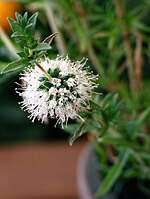
نعناع أيلي Mentha cervina نعناع آلاياوي Mentha alaica نعناع ثعلبي Mentha alopecuroides النعناع الجنوبي Mentha australis 
نعناع حقلي Mentha arvensis 
نعناع حلو الرائحة Mentha suaveolens نعناع داهوري Mentha dahurica نعناع دغيلي Mentha dumetorum نعناع دلمطيقي Mentha dalmatica نعناع رخو الأزهار Mentha laxiflora نعناع صغير الزهرة Mentha micrantha 
نعناع طويل الأوراق Mentha longifolia نبات عشبي معمر، موطنه بلاد الشام ومصر والمغرب العربي وأوروبا. نعناع غابي Mentha nemorosa نعناع فلفلي Mentha × piperita ينمو برياً في مناطق كثيرة ويزرع للإنتاج التجاري، موطنه أوروبا. نعناع كبير الأزهار Mentha grandiflora 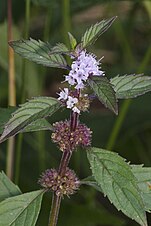
نعناع كندي Mentha canadensis موطنه كندا والولايات المتحدة. 
نعناع كورسيكي Mentha requienii نعناع لطيف Mentha gentilis 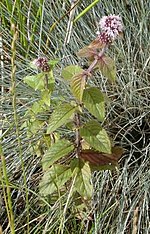
نعناع مائي Mentha aquatica موطنه بلاد الشام والمغرب العربي وأوروبا. 
نعناع مجدول Mentha verticillata موطنه المشرق العربي ومصر وتركيا واليونان وإيطاليا وفرنسا. وانتشر أيضًا في إسبانيا والمغرب. 
نعناع مستدير الأوراق Mentha rotundifolia نعناع ندغي Mentha saturejoides نعناع هرمي Mentha pyramidalis نعناع وبري Mentha villosa نعناع ياباني Mentha japonica نعناع باميري-آلاياوي Mentha pamiroalaica نعناع ديمني Mentha diemenica 
نعناع غاتفوسي Mentha gattefossei نعناع غايري Mentha gayeri نعناع قلبي Mentha cardiaca نعناع كارنتني Mentha carinthiaca نعناع كانينغهامي Mentha cunninghamii نعناع كومرلي Mentha kuemmerlei نعناع ليلكي غامق Mentha atrolilacina نعناع مكسيملياني Mentha maximilianea - نعناع أوروبي
- نعناع أيلي
- نعناع آلاياوي
- نعناع ثعلبي
- نعناع جنوبي
- نعناع حقلي
- نعناع حلو الرائحة
- نعناع داهوري
- نعناع دغيلي
- نعناع دلمطيقي
- نعناع رخو الأزهار
- نعناع صغير الزهرة
- نعناع طويل الأوراق
- نعناع غابي
- نعناع فلفلي
- نعناع كبير الأزهار
- نعناع كندي
- نعناع كورسيكي
- نعناع لطيف
- نعناع مائي
- نعناع مجدول
- نعناع مدبب
- نعناع مستدير الأوراق
- نعناع ندغي
- نعناع هرمي
- نعناع وبري
- نعناع ياباني
- نعناع باميري-آلاياوي
- نعناع ديمني
- نعناع غاتفوسي
- نعناع غايري
- نعناع قلبي
- نعناع كارنتني
- نعناع كانينغهامي
- نعناع كومرلي
- نعناع ليلكي غامق
- نعناع مكسيملياني
- النعناع الآسيوي (باللاتينية: Mentha asiatica)
- النعناع السخاليني (باللاتينية: Mentha sachalinensis)
من أنواع النعناع الواطنة في الوطن العربي:
- النعناع الأيلي (باللاتينية: Mentha cervina) في المغرب العربي وأوروبا
- النعناع البري (باللاتينية: Mentha pulegium) في مناطق الوطن العربي المتوسطية وتركيا والقوقاز وأوروبا
- النعناع طويل الأوراق (باللاتينية: Mentha longifolia) في بلاد الشام ومصر والمغرب العربي وتركيا والقوقاز وأوروبا، ويتبعه نويعان
- النعناع طويل الأوراق نويع التيفي (باللاتينية: Mentha longifolia subsp. typhoides) في بلاد الشام وقبرص وتركيا واليونان
- النعناع طويل الأوراق نويع طويل الأوراق (باللاتينية: Mentha longifolia (L.) L. subsp. longifolia) في بلاد الشام ومصر والمغرب العربي وتركيا والقوقاز وأوروبا
- النعناع المائي (باللاتينية: Mentha aquatica) أو النعناع الحامضي (باللاتينية: Mentha citrata) في بلاد الشام والمغرب العربي وتركيا والقوقاز وأوروبا
- النعناع المدبب (باللاتينية: Mentha spicata) في بلاد الشام ومصر والمغرب العربي وتركيا والقوقاز وأوروبا
- النعناع المدبب الكثيف (باللاتينية: Mentha spicata subsp. condensata) أو (باللاتينية: Mentha microphylla) في بلاد الشام ومصر وقبرص والبلقان وإيطاليا
- النعناع الهش (باللاتينية: Mentha crispata) في مناطق الوطن العربي المتوسطية وأوروبا.
المعلومات الغذائية
يحتوي كل 100غ من النَّعْنَاع بحسب وزارة الزراعة الأمريكية على المعلومات الغذائية التالية:
- السعرات الحرارية: 70
- الدهون: 0.94
- الدهون المشبعة: 0.24
- الكاربوهيدرات: 14.89
- الألياف: 8
- البروتينات: 3.75
التاريخ
كان الإغريق والرومان كانوا يضعون أكاليل النعناع فوق رؤوسهم في احتفالاتهم، وولائمهم، ويضعوا النعناع على موائد الطعام، كما عمل الطهاة عندهم على وضع النعناع في خلطات الطعام والمرق، كما مزجوا الخمور بنكهة النعناع وزيت النعناع، وكان الأطباء الإغريق يستعملوا نوعين من النعناع في وصفاتهم الطبية. ولكن لا يُعرف ما إذا استعملوا نفس النوع الرائج عندها، وقد استعمل بكثرة هذا النوع من النعناع في أوروبا بواسطة الأطباء، في حوالي منتصف القرن الثامن عشر ميلادي.
وذاع صيت بعض المدن كالمدينة المنورة في زراعة أنواع مختلفة منه؛ كالنعناع المغربي والنعناع الحساوي والنعناع الدُوش. وهذا النبات من أكثر النباتات شعبية واستعمالاً، يستخدم كتابل لبعض أطباق الطعام وفي نكهة وتعطير الشاي، كما يستعمل الطازج منه في طبق السلطة والتبولة الشهير في سوريا ولبنان وتحضير بعض أنواع السندويتشات، ويستعملون مسحوق أوراقه كأحد التوابل في تحضير بعض أطباق الطعام الشرقية. لأنواع المشهورة والمرغوبة، ونعناع المدينة له صفة وميزة قلما تجدها في غيره من النباتات الورقية، ورائحة نعناع المدينة نفاذة ورائعة وما أجمله عند قطفه ووضعه في الشاي، حيث يجعل من الشاي مشروبا ساخنا جميلا.
الاستعمال
المطبخ
تستخدم أوراق النعناع في الطبخ، طازجةً أو مجففة، ويكون الورق الطازج مُفضل أكثر من المُجفف عندما لا يشكل تخزينهُ مشكلة. وللأوراق مذاق دافئ، ومنعش، وعطري وحلو، ويبقى طعم بارد بعد تناوله. ويستخدم النعناع في إعداد الشاي، والمشروبات، والحلويات الهلامية، والشرابات، والكعك، والمثلجات. ويستخدم النعناع في مطبخ الشرق الأوسط على أطباق لحم الخروف، بينما يستخدم في المطبخ البريطاني والأمريكي في إعداد صلصة النعناع، وحلوى النعناع الهلامية.
ويعتبر النعناع عُنصراً أساسياً في تحضير الأتاي، وهو شاي مشهور في شمال أفريقيا وفي الدول العربية. ويستخدم النعناع بعض الأحيان كطعم أو تابل في المشروبات الكحولية.
وزيت النعناع والمنثول يستخدم بشكل واسع في إضفاء نكهة لمعطرات النفس، والمشروبات، ومطهرات غسول الفم، ومعاجين الأسنان، والعلكة، والحلويات. المواد التي تُعطي النعناع نكهته ومذاقه هي المنثول (والتي تعد العنصر الأساسي لرائحة النعناع)، والبوليغون.
الطب
ومن الأمراض التي يُعالجها النعناع:
يصنع من النعناع لبخة(عبارة عن ورقة نعناع مع لباب الخبز الأبيض والخل) ويستعمل لتسكين الالام العصبية وطريقته يوضع كيس من الشاش مملوء باللبخة المصنوعة بعد تسخينها فوق موضع الالم
يغلى النعناع في الماء لفترة وجيزة ويضاف اليه بعد إنزاله من على النار نسبة سكر(ونحذر مرضى السكر من إضافة السكر) فيمكنهم شربه بدون سكر فهو مقبول الطعم طيب الرائحة(وننصح أيضا بعدم شرب النعناع عند الشعور بالقيء أو الحميات)
أولاً
يعتبر شراب النعناع دواء نافع في معالجة اضطرابات المرارة، وتسكين المغص المعوي، ومغص أسفل البطن، وآلام الحيض، وطرد الغازات المعوية.
ثانياً
ويحتوى النعناع على زيت طيار (المنثول) ،ومواد دابغة مسكنة للتشنجات، وطاردة لمرض الالتهاب الكبدى، ومضاد للالتهابات
والنعناع صديق القلب، ومريح للاعصاب، وحبيب الجهاز الهضمى، يبعث القوة في الجسم
يسهل التنفس ويدر البول، يخفف من شدة حساسية المعدة المخاطى.
وكما يستعمل لعلاج الروماتزم والمفاصل والالتهابات
و لكن النعناع له نوع اخر يعرف بالحبق في نجد في شبه الجزيرة العربية.
قال ابن قيم عن الحبق: (شمه ينفع من الصداع الحار. ويجلب النوم ومسكن للمغص ومقوي للقلب). وأضاف ابن سيناء: “إن أزهاره منشطة وهاضمة وتزيل الصداع الناتج من الزكام”.


نبات النعناع
النعناع Mint نبات عشبي عطري معمر مشهور جداً قلما تجد بيت يخلو منه .. أوراقه مميزة ذات لون أخضر .. تراه في الأسواق وفي حدائق المنازل على شرفاته .. نبات لذيذ الطعم لاذع المذاق .. طيب الرائحة رائحته تعطر جو المكان الموجود فيه .. يستخدم بشكل شبه يومي في المشروبات الساخنة وفي السلطات وفي الأطعمة المختلفة .. يحتوي على فوائد كثيرة .. ينمو ويمتد بشكل أفقي ويصل ارتفاعه إلى حد 30 سم.
يتميز النعناع بكونه نبات سريع النمو وسريع الانتشار فتجد الكثير من النموات الجديدة تنمو جانب بعضها .. وتتعجب من سرعته في النمو .. النعناع عندما ينمو تراه يرسل جذور أو أذرع فوق التربة هذا هو السبب في انتشاره السريع .. يفضل زراعة النعناع في أحواض طويلة داخلياً كونه يحب الانتشار .. أو يمكن زراعته خارجياً على جانب الممرات كونه لا يحتاج الى مساحة عريضة وكبيرة .. فقط مساحة صغيرة بشكل طولي على امتداد الممر يمكن أن تصبح مليئة بالنعناع .. ويمكن أن تراه في زجاجات بلاستيكية أو أحواض كبيرة وهو ينمو ويزدهر ويتأقلم في أي مكان تزرعه فيه وتضعه فيه.. اذا لم تكن تملك نبتة نعناع فيفضل احضار النبتة وزراعتها في بداية فصل الربيع وفي هذه الأوقات ترى النعناع منتشراً في كل مكان ..
كيف تجعل النعناع يعيش أطول فترة ممكنة داخل البيت ؟
زراعة النعناع داخلياً وبأحواض أمر غاية في السهولة .. يفضل أن يوضع في مكان به ضوء بعيد عن أشعة الشمس أو أن تصله شنس الصباح الخفيفة وهذا لا يضر .. مع أن النعناع يتحمل درجات البرودة الخفيفة إلا أن الأفضل له العيش تحت درجة حرارة معتدلة صيفاً وشتاءً .. نبات النعناع يحب الري بانتظام .. وعند جفاف سطح التربة فهذا مؤشر على أن التربة بحاجة للري مرة أخرى .. والرطوبة مهمة للنعناع حاول دائما ترطيب النبتة وذلك برشها برذاذ الماء كلما أمكن.
يحتاح النعناع الى تربة زراعية جيدة التصريف أو أي تربة أخرى مثلاً رملية المهم أنها جيدة التصريف .. التسميد غير ضروري للنعناع فهو نبات نشط وغزيز الإنتاج وبدون أي مقويات لكن اذا أحببت يمكنك تسميده بسماد عضوي بعيداً عن الأسمدة الكيماوية لمرة واحدة خلال العام.. قد تتعرض نبتة النعناع لبعض الافات والأمراض وغالباً السبب يكون قلة تصريف المياه والتهوية السيئة في المكان.
في الأشهر الباردة قد ترى توقف وضعف نمو نبات النعناع ويصبح في حالة خمول وقد تسقط الأوراق وتصبح النبتة أشبه بالميتة ! لكن لاتقلق فهذه الحالة سرعان ما تزول عندما تعود درجة الحرارة للارتفاع فمعروف عن نبات النعناع أن جذوره قوية وتصمد مع البرودة .. وستعود النبتة النمو من جديد.
كيف يمكن اكثار النعناع ؟
يمكن اكثار النعناع بالنموات الجانبية أو التعقيل في الماء .. يمكن ببساطة أخذ أحد تلك النموات بجذورها وزراعتها في أصيص آخر .. او اذا أردت التعقيل في الماء بامكانك قص عقلة أو مجموعة من العقل الطرفية بطول 10-15 سم من نبتة أخرى .. وتزيل الأوراق السفلية وتضع العقل في كأس من الماء ووضعه بجوار شباك يصله ضوء الشمس الطبيعي .. وبعد مدة قليلة سترى نمو الجذور لهذه العقلات ثم يمكنك نقلها لحوض به تربة جيدة وضعه في مكان مناسب.
تقليم وقطف النعناع
النباتات العشبية مثل النعناع يفضل تقليمها بين الحين والأخر مثلها مثل الريحان واكليل الجبل لحثها في النمو والانتشار .. بالنسبة للنعناع يفضل قطف الأوراق الطرفية أو رؤوس الأفرع متى ما شئت .. ويفضل قص الزهور الجديدة التي تنمو عندما تبدأ النبتة في التزهير كون الزهور تخفف من معدل نمو النبتة .. الأوراق يفضل استخدامها بشكل فوري في الطعام والشراب .. أو يمكنك تخزينها في الفريرز اذا رغبت في أن تحتفظ بطعمها ورائحتها لأوقات قادمة .. يمكنك القيام بعملية قص وتقليم جائر لنبات النعناع بمعدل مرتين خلال العام .. وذلك بقص جميع أطراف السيقان العلوية والإبقاء على ربع طول الساق من أسفل .. هذه العملية ستشجع على نموات جديدة وستجعل النبتة كثيفة أكثر.
فوائد النعناع
يدخل النعناع في صناعة معجون الأسنان كونه يسكن وجع اللثة والأسنان ولرائحته المنعشة للفم .. ومعروف عنه أنه مهدئ للأعصاب وطارد للحشرات.. ولا ننسى أنه يذكرنا بالصيف ويضيف النكهات الرائعة على المشروبات الساخنة كالشاي ومشروب النعناع ويدخل في المشروبات الباردة كالليمون والنعناع وفي السلطات والأطعمة.


